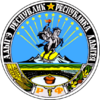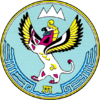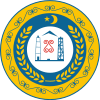Coat of arms of Russia
| Coat of arms of Russia |
 |
| Details |
| Adopted |
November 30 1993
December 20, 2000 (confirmed) |
| Crest |
Three Imperial Crowns of Russia |
| Escutcheon |
Gules, Saint George mantled azure on a horse trippant to sinister argent trampling a Dragon sable |
| Supporters |
A double-headed eagle Or displayed |
| Other elements |
The whole arms are themselves on an escutcheon gules. The eagle clutches a sceptre Or in dexter talon and a globus cruciger Or in sinister talon |
The coat of arms of the Russian Federation derives from the earlier arms of the Russian Empire, as restored in 1992 after the collapse of the Soviet Union. Even if it has undergone several modifications since the reign of Ivan III (1462-1505), the current Coat of Arms is directly derived from the various precedent versions. The general chromatic layout corresponds to the early 15th century standard . The shape of the eagle can be traced back to the times of Peter the Great (Peter I), although the eagle in the modern arms is gold in preference to the imperial black.
The two main elements of Russian state symbols (the two-headed eagle and the mounted figure slaying a serpent or dragon) predate Peter the Great. The Great State Seal of Ivan III, Duke of Moscow, featured a horse rider slaying (or struggling with) a dragon. The figure was not officially identified as Saint George until 1730, when it was described as such in an Imperial decree. The older form (a mounted dragon slayer known as Saint George the Victory-bearer, "Победоносец") was always associated with the Grand Duchy of Muscovy, later becoming the official arms of the city of Moscow. The earliest graphic representation of a rider with a spear (1390) figures in a seal of the prince of Moscow, Vasiliy Dmitriyevich. The serpent or dragon was added under Ivan III. Saint George henceforth became the patron of Moscow (and, by extension, of Russia). Today, the official description does not refer to the rider on the central shield as representing Saint George, mainly in order to maintain the secular character of the modern Russian state.
The double-headed eagle was adopted by Ivan III after his marriage with the Byzantine princess Sophia Paleologue, whose uncle Constantine was the last Byzantine Emperor. The double-headed eagle was the official state symbol of the late Byzantine Empire, spanning both East and West. It, amongst other aspects, symbolized the unity of Church and State. After the Fall of Constantinople to the Turks in 1453, Ivan III and his heirs considered Moscovy (Moscow) to be the last stronghold of the true, orthodox, Christian faith, and in effect, the last Roman Empire (hence the expression "Third Rome" for Moscow and - by extension - for the whole of Imperial Russia). From 1497 on the double-headed eagle proclaimed a Russian sovereignty equal to that of the Holy Roman Empire, whose rulers likewise claimed to be the inheritors of the Christian Roman tradition. The earliest known evidence of the double-headed eagle as an official emblem of Russia is on the great prince's seal, stamped in 1497 on a Charter of share and allotment of independent princes' possessions. At the same time the image of the gilded double-headed eagle on red background appeared on the walls of the Palace of Facets in the Moscow Kremlin.

Lesser State Emblem of the Russian Empire (final version, 1883)
Under the first tsar of the Romanov dynasty, Mikhail Feodorovich, the image of the coat of arms changed. In 1625 the double-headed eagle was adorned with three crowns for the first time. Through time, the latter have alternatively been interpreted at the conquered kingdoms of Kazan, Astrakhan and Siberia, or as the unity of 'All the Russias' - Grand Russia (Russia), Little Russia (today's Ukraine) and White Russia (Belarus).
The modern variant of the coat of arms was designed by artist Yevgeny Ukhnalyov it is adopted 30 November 1993 [1]. Today, the imperial crowns stand for the unity and sovereignty of Russia both as a whole and in its subdivisions (republics and regions). The orb and sceptre are traditional heraldic symbols of sovereign power and autocracy. It has been decided to retain them in the modern Coat of Arms of Russia despite the fact that the Russian Federation is not a monarchy, which led to objections by the Communists. However, after having lost both the blue band of the Order of St. Andrew supporting the three crowns and the corresponding Chain surrounding Moscow's shield, the modern Coat of Arms of Russia was (re-)instated by decree in 1993, and the corresponding law act was paraphed by President Vladimir Putin on December 20, 2000.
See also
- National emblems of the Russian Empire
- Coat of arms of the Russian SFSR
- Coat of arms of Moscow
- Flag of Russia
External links
|
Coats of arms or emblems of the republics of Russia |
|
| |
 Adygea
 Altai
 Bashkortostan
 Buryatia
 Chechnya
|
 Chuvashia
 Dagestan
 Ingushetia
 Kabardino-Balkaria
|
 Kalmykia
 Karachay-Cherkessia
 Karelia
 Khakassia
|
 Komi Republic
 Mari El
 Mordovia
 North Ossetia-Alania
|
 Sakha Republic
 Tatarstan
 Tuva
 Udmurtia
|
|
|
|
Coats of arms of Europe |
|
Sovereign
states |
|
|
Dependencies,
autonomies,
other territories |
Abkhazia 2 · Adjara1 · Adygea · Akrotiri and Dhekelia · Åland · Azores · Bashkortostan · Chechnya · Chuvashia · Crimea · Dagestan · Faroe Islands · Gagauzia · Gibraltar · Guernsey · Ingushetia · Jan Mayen · Jersey · Kabardino-Balkaria · Kalmykia · Karachay-Cherkessia · Republic of Karelia · Komi Republic · Kosovo · Madeira7 · Isle of Man · Mari El · Mordovia · Nagorno-Karabakh1 · Nakhchivan1 · North Ossetia-Alania · Northern Cyprus1 · South Ossetia 2 · Svalbard · Tatarstan · Transnistria · Udmurtia · Vojvodina
|
|
| Italics indicates an unrecognised or partially recognised country. 1 / 7 Entirely in Asia / on the African Plate, but historically considered European. 2 Partially or entirely in Asia, depending on the border definitions. 3 Has part of its territory in Asia. |
|
|
Coats of arms of Asia |
|
Sovereign
states |
Afghanistan · Armenia1 · Azerbaijan1 · Bahrain · Bangladesh · Bhutan · Brunei · Burma2 · Cambodia · People's Republic of China · Cyprus1 · East Timor3 · Egypt4 · Georgia1 · India · Indonesia · Iran · Iraq · Israel · Japan · Jordan · Kazakhstan4 · North Korea · South Korea · Kuwait · Kyrgyzstan · Laos · Lebanon · Malaysia · Maldives · Mongolia · Nepal · Oman · Pakistan · Philippines · Qatar · Russia4 · Saudi Arabia · Singapore · Sri Lanka · Syria · Tajikistan · Republic of China5 · Thailand · Turkey4 · Turkmenistan · United Arab Emirates · Uzbekistan · Vietnam · Yemen
|
|
Dependencies,
autonomies,
other territories |
Aceh · Adjara1 · Abkhazia1 · Akrotiri and Dhekelia · Altai · British Indian Ocean Territory · Buryatia · Christmas Island · Cocos (Keeling) Islands · Guangxi · Hong Kong · Inner Mongolia · Iraqi Kurdistan · Jakarta · Khakassia · Macau · Nagorno-Karabakh · Nakhchivan · Ningxia · Northern Cyprus · Palestine (Gaza Strip · West Bank) · Papua · Sakha · South Ossetia1 · Tibet · Tuva · West Papua · Xinjiang · Yogyakarta
|
|
| Italics indicates an unrecognised or partially recognised country. 1 Sometimes included in Europe, depending on the border definitions. 2 Also known as Myanmar. 3 Sometimes included in Oceania, and also known as Timor-Leste. 4 Transcontinental country. 5 Commonly known as Taiwan. |
|

